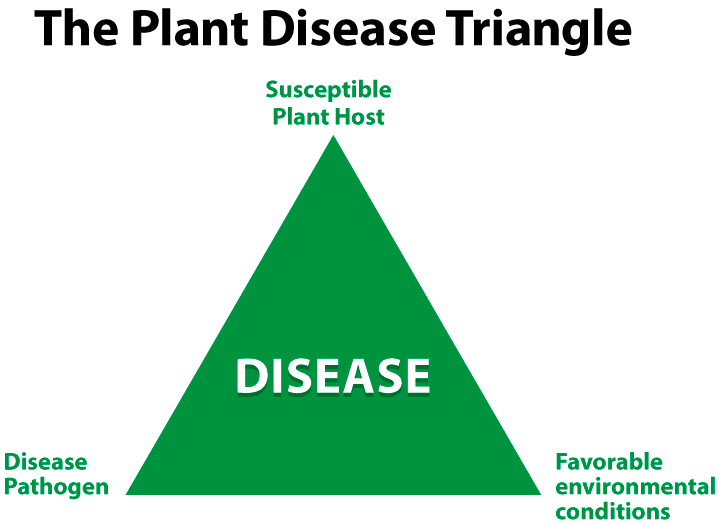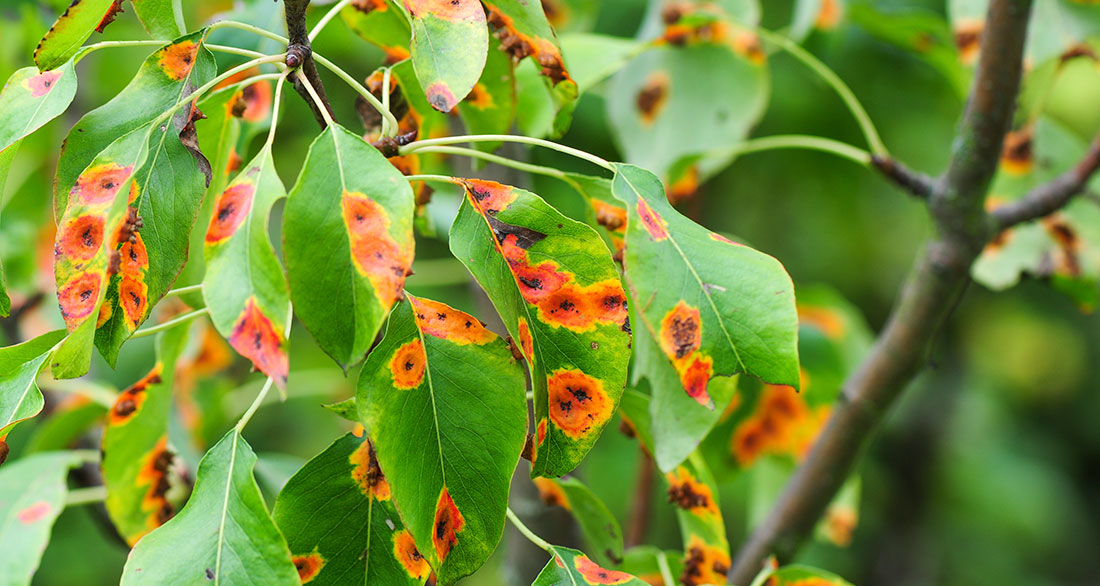INTRODUCTION TO PLANT DISEASES
Landscape plants suffer from a wide variety of plant diseases and disorders. Plant disease can be separated into biotic diseases and abiotic disorders. Biotic diseases are caused by living microorganisms such as fungi, bacteria, viruses, or phytoplasmas. Abiotic disorders are caused by environmental factors such as frost, saline soil, extreme heat, drought, or herbicide drift.
The Disease Triangle
Plant diseases result from the interaction of a susceptible host, a disease causing agent, and an environment that is favorable to disease development. Disease can be controlled by altering one of the three elements in the disease triangle. If the host is not susceptible, the pathogen is not present or the environment is not favorable, then the disease will not develop. Host resistance is the most effective means to control plant diseases. When selecting plants for a landscape, it is critical to take into account diseases that are prevalent in the area and select species or varieties that are immune or highly resistant. It is not practical to depend on treatments or frequent application of pesticides to control plant diseases.
The Importance of Proper Plant Selection
The most effective means to control plant disease is the use of resistant varieties. This is true for all plant diseases. In many cases there are no treatments or chemical controls that will prevent infection or control the pathogen responsible for the disease. The following contains general information on the most common diseases seen in Los Angeles County landscapes which includes powdery mildew, rust, root rot, fire blight, bacterial scorch, cankers, leaf spots, anthracnose, galls, downy mildew, and vascular wilt. For assistance with plant disease identification and control, as well as identification and management of abiotic plant disorders, contact the County Plant Pathologist using the information in Appendix I.
Tips for Recognizing Abiotic Disorders of Plants
Disease-causing fungi, bacteria, and viruses are all living organisms so plant damage caused by them is considered “biotic”. Non-living, or “abiotic”, factors can also cause plant damage and include things like sunburn, frost, herbicide drift, and mechanical damage. The symptoms are often very similar between biotic diseases and abiotic disorders. Patterns and how fast a plant is affected are more important than specific symptoms when trying to decide if it is an infectious disease or an abiotic disorder. Diseases usually start at one spot or several spots in a field and spread out over time, for example rust or powdery mildew. If a group of plants show symptoms very quickly, like overnight, and it does not spread, it is more likely abiotic. Think about herbicide drift or frost. If the plants look good on one day and in poor condition the next, but then over the next week or two no other plants show any symptoms, this suggests a one-time event damaged the plants. On the other hand, an actual disease usually starts on one plant, and, as that plant declines or shows progressive symptoms, other plants of the same species start showing the same symptoms as the disease spreads. Another example would be a brown spot on turf from dog urine. The grass shows rapid death where the dog urinated but the spot does not get any bigger over time. If it were a fungal disease, the spot would get bigger over time and more spots would appear that also enlarge over time.


